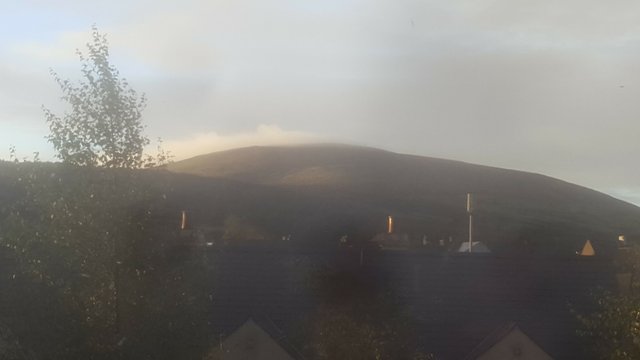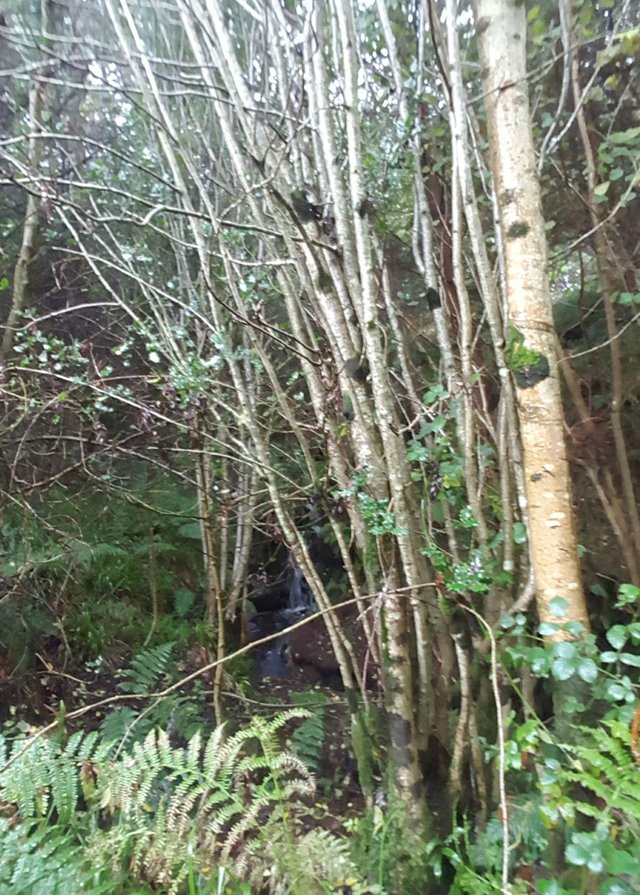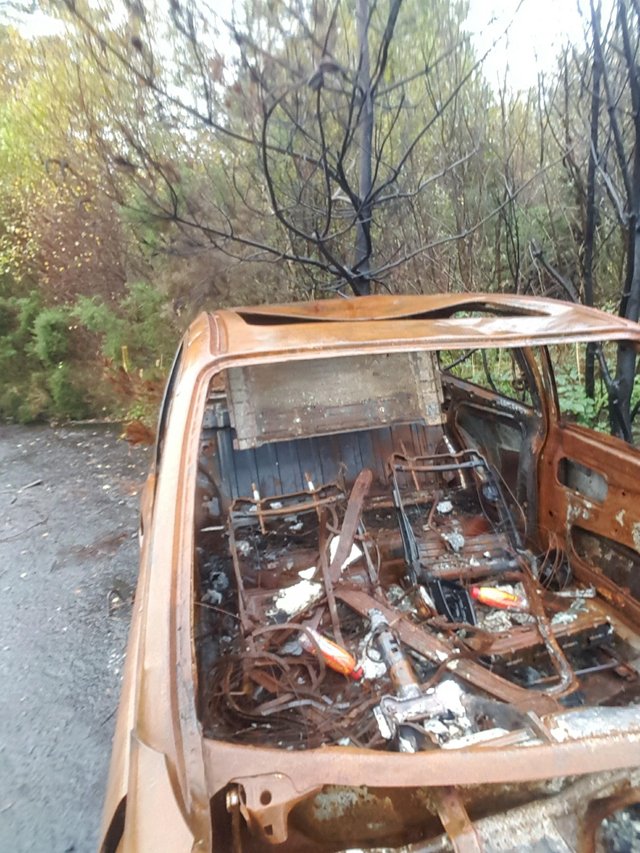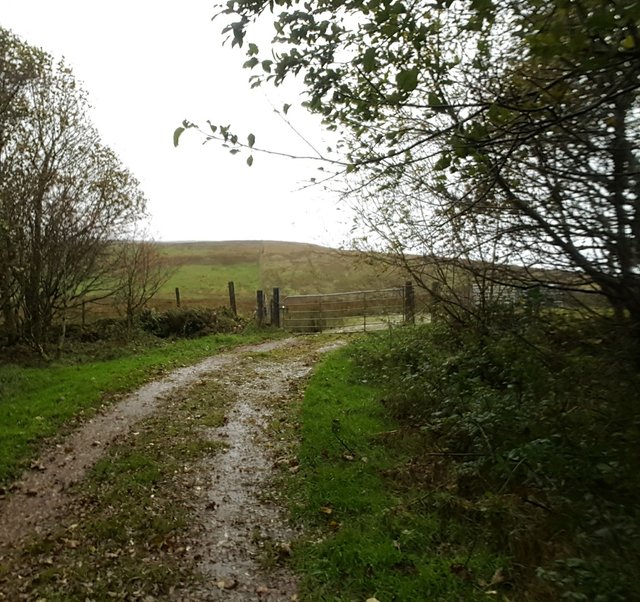Lo! the mountain
There's a neat little cabin on the slopes of fair Knocklayde
It's lit by love and sunshine where the heather honey's made...
The cold front, they said, would pass over Ballycastle on Monday night, dumping its rain while my son and I sat in a warm pub watching Manchester United play Liverpool. Tuesday would be cold, dry, and mostly clear. I’d planned to climb Knocklayde, the hill looming above Ballycastle, for some time now. This would be perfect weather for an early-Autumn hike.
Looking from my son’s steamed-up kitchen window just after dawn, the morning mountain had a thick veil of cloud, and it looked like the front hadn’t quite passed over us. There was still rain to dump. Squalls whipped against the glass. Trees in the street shivered a little. But it was a two-hour walk up through the forested slopes before I even got to the mountain itself, and by then the skies would have cleared.

The son couldn’t live up to his squiffy commitment to join me. His hungover housemate mumbled something about false summits, and stumbled back to bed. I set out through the Co Antrim town’s rush hour - a few cars and vans, a lollipop-man in wet-weather gear shepherding schoolkids who’d made no such concession to the rain. And sure, why would they. It was going to clear up in an hour or so, wasn’t it?
Ballycastle isn’t famous for much. Marconi had an early triumph in radio telegraphy when he set up a wireless link across the narrow strait to Rathlin Island - alerting London’s insurance underwriters to incoming Atlantic vessels. Every year the town hosts a well-known Lammas Fair, which brings many thousands of visitors and whose trademark sweets, honeycomb and yellowman, feature in ‘The Oul’ Lammas Fair’, a relatively well-known Irish ballad.
At the ould Lammas Fair boys were you ever there
Were you ever at the Fair In Ballycastle-O?
Did you treat your Mary Ann To some Dulse and Yellow Man
At the ould Lammas Fair in Ballycastle-O!
Like most of the people who think they know the song, I suspect, I’d really only known that chorus. I’d read, just the night before, on a tourist information plaque, that it had been written by local fiddle-player and wood-carver John Henry MacAuley. It was the only one of his songs to receive anything approaching fame - Ottilie Patterson and Ruby Murray both releasing versions back in the day. Like many popular Irish ballads, it’s a sentimental piece of nostalgia - a homesick blues, if you like. But I hadn’t realised that the speaker’s exile isn’t the displacement of emigration - he’s not in Americay - but of war. ‘The Oul’ Lammas Fair’ is a kind of war poem, a trench-song:
In Flander's fields afar while resting from the War
We drank Bon Sante to the Flemish lassies O!
The route to the mountain starts from the entrance to Ballycastle forest, and once through the roofed lych-gate-like entrance to the forest the mountain itself is lost to view. In fact, now that I thought of it, all 514 metres of Knocklayde had been lost to view for the last 20 minutes: the rain had grown stronger, the cloud had lowered, I’d kept my head down. Now and then, stray sunshine pushed down through the reddening canopy - like most of Northern Ireland’s forests, Ballycastle’s is largely coniferous, but the path is edged with deciduous plantings. Streams chuckle off the hillsides in ditches and small waterfalls.

There are four or five kilometres of forest path, straight at first as what’s known as the Glentaisie Way follows the track of an old railway. Then it winds up the flank of the hill before the hill itself is revealed. Here, I could see little even of the nearest trees: the rain was now so heavy that my glasses were useless and had to be tucked in a pocket.
Then something cut across the path in front of me. Even without my specs I saw that it wasn’t one of the red squirrels who have made a last stand in this and a few other Antrim forests. Rabbit? Too big and red. Hare? In woodland?
Well, probably. The Irish hare, Lepus timidus hibernicus, is probably a subspecies of the mountain hare and seems to prefer semi-natural grassland, heath or bog. But I’ve been told that it will come off exposed upland moors into woods for shelter. In fact, if I had to nominate a spirit animal or totem, this reddy-brown loper would be a candidate. Preferring solitude, but happy in small groups. At home in wild places, but adaptable enough to colonise airports. If I get to come back, maybe I could… My fellow rain-walker skipped across a wet pathside drain into bracken and was gone.
And after a while the path curved back on itself and divided, part of it the official Moyle Way walking trail, part of it a gravelled roadway where someone had abandoned and burned out a stolen car. Time and weather had stripped it down like an overzealous mechanic.

A few minutes later a woman in running gear jogged past. “I thought I was the only mad one,” she laughed. I watched her trot into the mist that seemed even thicker now. The trees were thinning out. I checked my damp map. Over my right shoulder, that path uphill should bring my to the shoulder of the hill and the last stage of my hike. The proper climb. I reset my pack and trudged on. From what I’d read, this last open stage was a bit of a slog. And there were those false summits. But hey ho. A rain-slippery farm gate, a sheepfold, poached black peaty earth. And there, lo! The mountain.
A hump in wet fog.

I began zigzagging up the slope. Invisible burns trickled through the bog. I tried to follow a fence-line, but my thighs refused the gradient. The first of the false summits came and went, I hunkered down to catch a breath then ascended to the next. Stop again. Start again. And far from passing, the cold front was only now throwing the worst of its payload at Knocklayde, brutal winds and rain that desperately wanted to be, if not shards of broken glass, then sharpened hail.
There's a neat little cabin on the slopes of fair Knocklayde
It's lit by love and sunshine where the heather honey's made
With the bees ever humming and the children's joyous call
Resounds across the valley as the shadows fall...
Well. There would be precious little honey made this morning. I was above the treeline, and the sweet little cabin MacAuley envisaged, if it ever existed, lay on the other side of the mountain in Glenshesk, one of the nine glens of Antrim. I kept the fence line in view as best I could, consulted a map that was almost as wet as I was, and yomped my way through rushes and turf-outcrops to slightly flatter ground. An angle to my left and, though I couldn’t see it, I was approaching the summit and its cairn.

This is Carn na Truagh, the unexcavated cairn of sorrows, and the howling gale was reason enough to be sorrowful. Bowed against the weather I circumnavigated the cairn - a heathery bump with a few scattered boulders like a broken necklace on its western flank and a concrete ordnance survey trig point on top. I was cold, wet, and elated. I already on my way down.